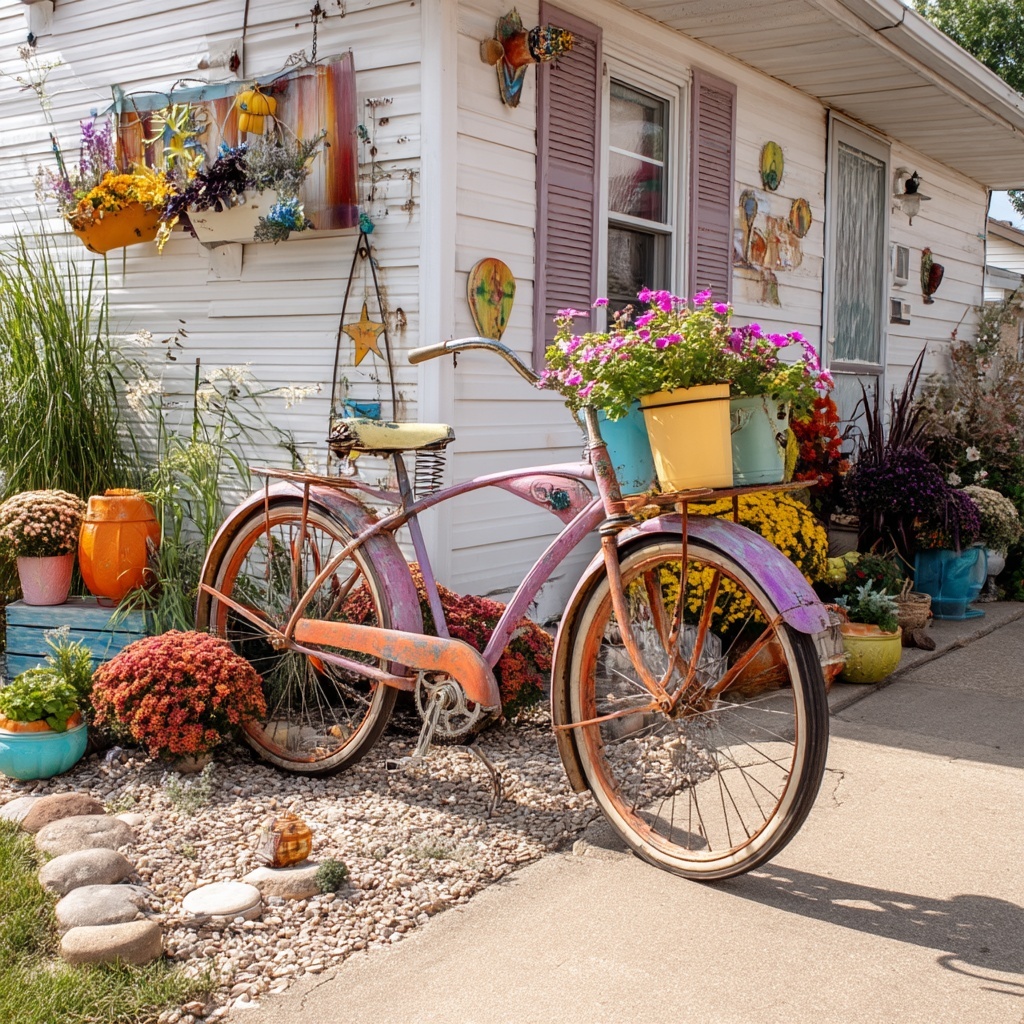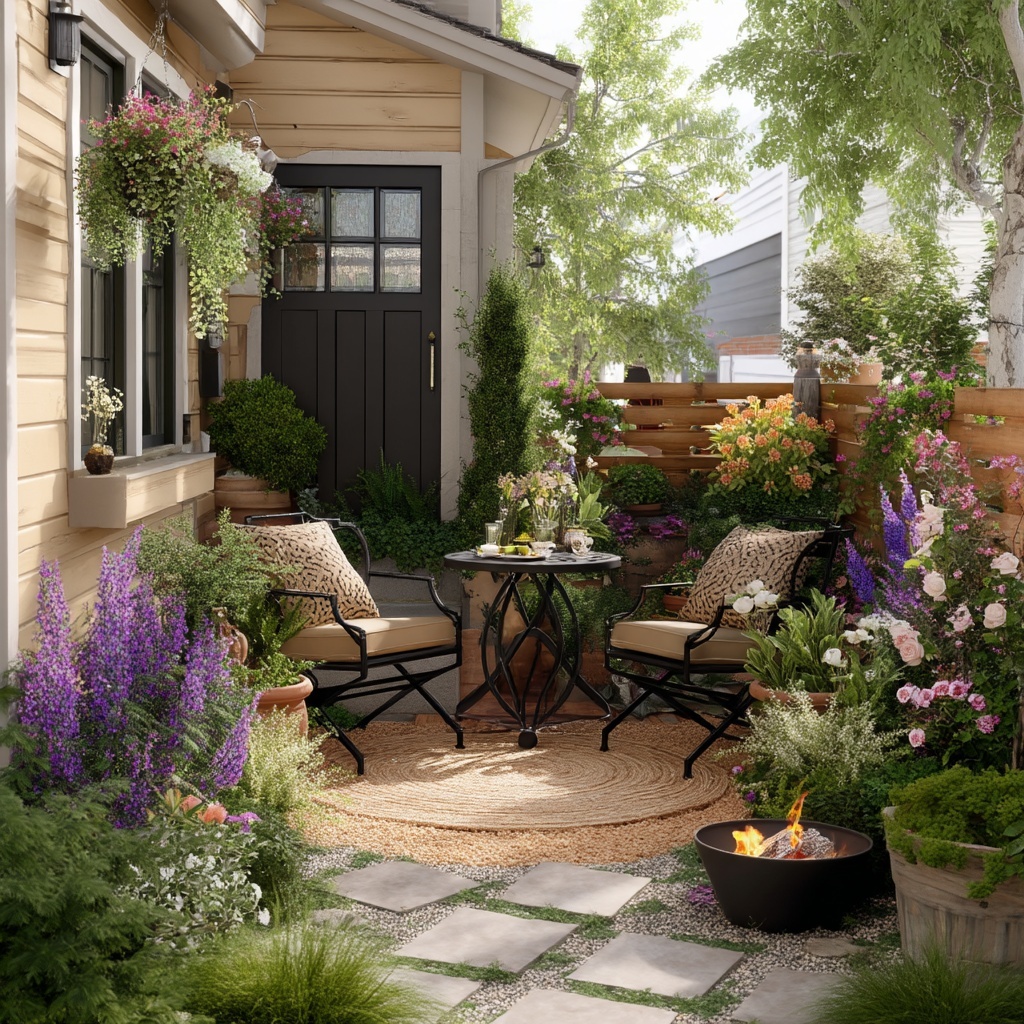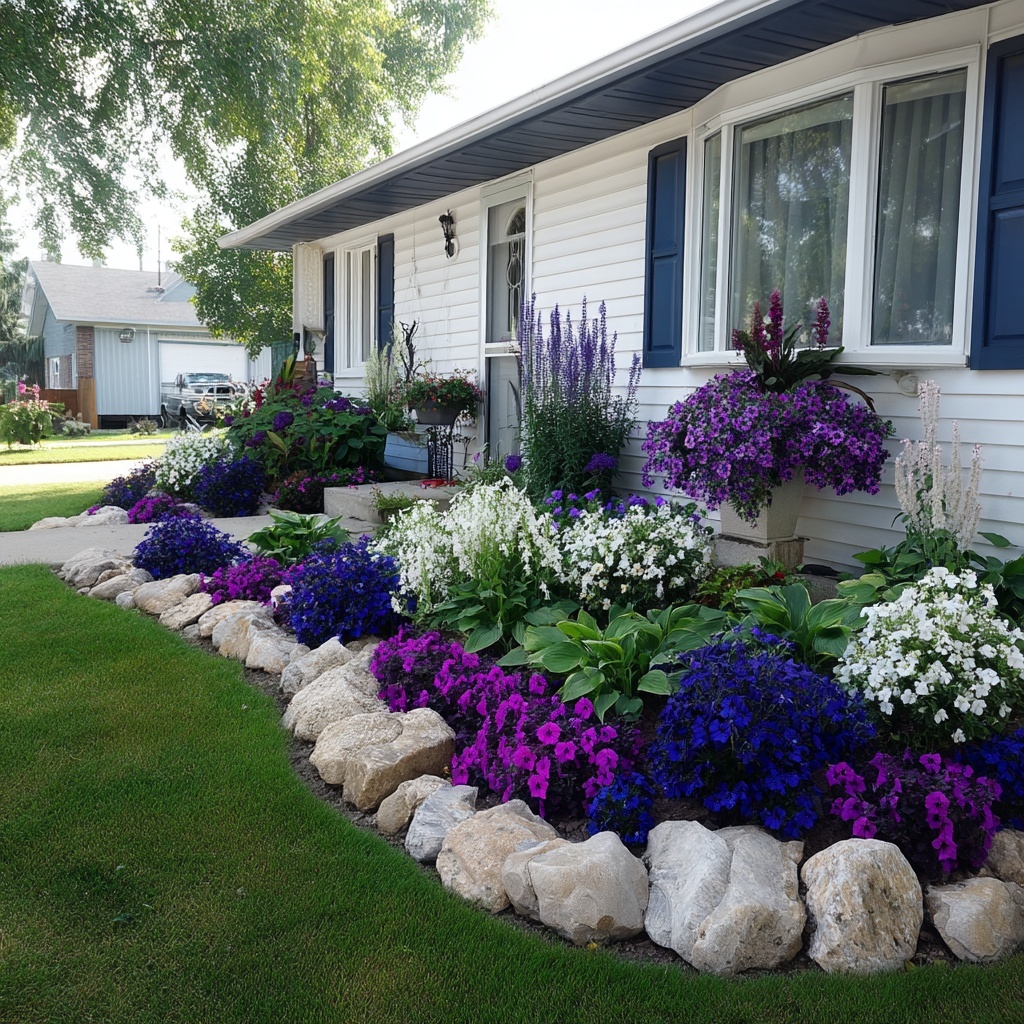Small front yard landscaping doesn’t have to feel limiting—in fact, it’s the perfect canvas for creativity, curb appeal, and smart design. Whether you’re working with a tiny lawn or a slim pathway, you can turn that modest patch of green into a welcoming and stylish space. The secret lies in using scale-friendly plants, multifunctional elements, and a touch of personal charm to maximize every inch. In this guide, we’ll walk through nine inspiring ideas to help you transform your front yard into a low-maintenance, eye-catching retreat that enhances your home’s entrance—without overwhelming it.
Table of Contents
1. Update Your Entryway
When it comes to small front yard landscaping, the entryway is your first and best opportunity to make a strong visual impression. A thoughtful front entrance doesn’t just enhance curb appeal—it also sets the tone for your entire outdoor space.
Consider these elements to elevate your entryway:
- Defined Walkways: Use brick, natural stone, or concrete pavers to create a clear, welcoming path. Curved walkways can make narrow spaces feel wider and more inviting.
- Window Boxes: Install flower-filled window boxes beneath front-facing windows. Choose trailing plants like ivy geraniums or petunias to add color and texture without taking up ground space.
- Compact Trees: Ornamental trees such as dwarf dogwoods or Eastern redbuds can act as focal points beside your door or along the path—just make sure to plant them a safe distance from your foundation.
- Lighting: Low-voltage path lights or solar-powered fixtures add both safety and evening charm without overpowering a small yard.
- Decorative Touches: A cheerful front door color, a custom doormat, or a simple metal gate can go a long way in enhancing personality without clutter.
Pro tip: If your walkway feels tight, use light-colored materials and diagonal lines to visually expand the space.
2. Select the Right Trees

Tree choice matters—especially when space is tight. The right tree can bring year-round beauty, provide shade, and add vertical interest without overwhelming your yard. In small front yard landscaping, smaller varieties are not only more practical but often more affordable and easier to maintain.
Top Picks for Small Yards:
- Dwarf Alberta Spruce
A compact, conical evergreen that stays neat and tidy all year. Ideal near porches or walkways, it tops out around 4–6 feet, making it a great choice for symmetry or foundation planting. - Eastern Redbud
With heart-shaped leaves and soft pink spring blossoms, this small native tree adds seasonal flair. It works beautifully as a centerpiece or corner anchor without growing out of control. - ‘Wolf Eyes’ Dogwood
A slow-growing variety with creamy white-edged leaves and elegant white blooms. Its mature height of around 10 feet makes it manageable while offering color from spring to fall.
Tree Planting Tips:
- Leave enough distance between your tree and the house (at least 10 feet), especially for root growth and structural safety.
- Choose native or well-adapted trees for your region to reduce water needs and disease risks.
- For ultra-small spaces, plant your tree in a large decorative pot to control size and add flexibility.
Pro tip: Use mulch around the base of your tree to retain moisture, suppress weeds, and give a finished look that ties the space together.
3. Make it No-Mow

Maintaining a patch of turf in a compact yard often means more work than it’s worth. Luckily, small front yard landscaping doesn’t require a lawn at all. With a no-mow approach, you can create a polished, practical space that looks great year-round—without dragging out the mower.
Low-Maintenance Lawn Alternatives:
- Creeping Phlox
This flowering ground cover spreads easily and bursts into color each spring. It’s drought-tolerant and forms a dense mat that crowds out weeds naturally. - Lilyturf (Liriope)
Ideal for edging or filling in tricky corners, lilyturf produces lavender blooms in summer and thrives with minimal care. - Sweet Woodruff
Best for shady areas, this fragrant ground cover forms lush green carpets and resists pests like deer and rabbits. - Indiangrass (with caution)
This tall, golden grass adds texture and movement in the fall. However, it’s not suitable for fire-prone regions due to its flammability. - Decorative Mulch + Stepping Stones
Combine organic mulch (like pine bark) with stone pathways or gravel pockets to define spaces while keeping maintenance low.
Why Skip the Lawn?
- Less watering, mowing, and edging
- Encourages pollinators with flowering varieties
- Safer for kids and pets with no chemicals or machinery
- More room for creative features like sculpture, benches, or edible plants
Pro tip: Ground covers between stepping stones soften hardscapes and make the yard feel larger and more inviting.
4. Play Up Your Home’s Perimeter

The edges of your home offer some of the most valuable real estate in small front yard landscaping. Foundation plantings not only soften the base of your house but also frame the architecture, guiding the eye and giving your home a more polished look.
Easy Perimeter Planting Ideas:
- Use Flower Borders:
Add color with low-growing annuals or perennials like petunias, salvia, or geraniums. These flowers create a vibrant edge without blocking windows or doors. - Layer Heights for Depth:
Position taller plants like hostas or ornamental grasses at the back, with shorter blooms in front. This tiered effect adds visual interest and makes the space feel fuller without clutter. - Add Texture with Rock Accents:
Mix river rocks or flat stones into your planting beds. Not only do they help with drainage, but they also provide contrast against leafy greens and bright blooms. - Try Container Gardens:
If you’re short on planting space, arrange pots of various sizes along the perimeter. It’s flexible, easy to change with the seasons, and perfect for renters or HOA-restricted homes.
Quick Tips:
- Choose plants suited to your yard’s sun exposure—south-facing foundations can get hot, while north-facing ones stay cooler and shadier.
- Mulch to reduce weeds and keep moisture in, especially in narrow beds along walkways or driveways.
- Avoid placing dense shrubs too close to your siding, which can trap moisture and invite pests.
Pro tip: Repeating colors or plant shapes on both sides of your front steps creates symmetry and curb appeal.
5. Create a Border

A well-defined border can make a compact yard feel finished, structured, and more expansive. In small front yard landscaping, borders help organize the space, direct foot traffic, and highlight your favorite features—all without overwhelming the area.
Smart Border Design Ideas:
- Use Shrubs for Structure
Compact varieties like boxwoods, azaleas, and dwarf pines bring shape and year-round greenery. Group shrubs in odd numbers (3, 5, 7) to create a balanced, natural look. - Add Color with Flowering Shrubs
For seasonal interest, try:- Oakleaf Hydrangea: Offers big white blooms in summer and rich fall foliage.
- Red Twig Dogwood: Eye-catching red stems in winter and delicate spring flowers.
- Weigela: A favorite of hummingbirds, with pink or crimson blossoms that pop against green leaves.
- Mix Hardscape Elements
Pavers, bricks, or edging stones in contrasting colors can add elegance while clearly separating lawn, beds, and walkways. - Frame Driveways and Walks
Borders along paths and driveways make these functional areas feel purposeful and stylish—especially when filled with fragrant herbs, low-growing flowers, or ornamental grasses.
Border Placement Tips:
- Keep plantings 12–18 inches from hard surfaces to prevent overgrowth and allow for easy maintenance.
- Choose varieties that stay compact—no one wants to constantly trim back plants encroaching on walkways.
- Consider lighting along borders for nighttime curb appeal and added safety.
Pro tip: Curved borders tend to soften a small yard, while straight lines give a clean, modern feel—choose based on your home’s style.
6. Promote Individuality

Your front yard might be small, but it’s still a stage for your personality. The best small front yard landscaping ideas reflect who you are—whether that’s bold and creative or minimal and serene. Even a single standout feature can make your space memorable and uniquely yours.
Creative Ways to Add Personality:
- Repurposed Decor:
Turn an old bicycle, vintage watering can, or wheelbarrow into a playful planter. These upcycled items draw attention and make great conversation starters. - Garden Sculptures or Art:
Add a touch of whimsy with a metal sculpture, driftwood piece, or handcrafted ceramic accent. Look for weather-resistant items that complement your home’s style. - Custom Signage or House Numbers:
Stylish address markers or name signs carved from wood, metal, or slate make a front yard feel more intentional and inviting. - Seasonal Displays:
Rotate small elements throughout the year—think pumpkins in the fall, spring wreaths, or a pot of red blooms in summer—to keep your landscape fresh and festive. - Mini Features:
No space for a pond or gazebo? Try a tabletop fountain, vertical wall planter, or even a small trellis with climbing vines to add texture without taking up floor space.
Pro tip: Choose one or two standout elements—too many will make a small space feel cluttered instead of curated.
7. Bring on the Seating

Even a small yard deserves a place to sit and savor the outdoors. Thoughtful seating is a core part of small front yard landscaping, offering comfort, charm, and function—without eating up precious space.
Tips for Small-Space Seating:
- Go Compact and Cozy:
Choose slim-profile benches, foldable bistro sets, or built-in stone seating. Look for pieces that hug corners or line walkways to maximize open areas. - Keep It Weather-Ready:
Select materials like powder-coated metal, resin wicker, or treated wood that can handle the elements without constant upkeep. - Match Your Landscape Style:
A rustic wooden bench pairs beautifully with cottage-style plantings, while sleek metal chairs suit modern, minimalist yards. - Tuck Seating Into the Landscape:
Nestle a bench beneath a tree or place a single chair by a flowerbed for a personal retreat. Even a sturdy tree stump can serve as a natural seat or plant stand. - Add a Small Fire Pit (if allowed):
Portable fire pits add warmth and ambiance. Be sure to follow local safety regulations and keep it proportional to your space.
Smart Seating Placement:
- Place seats to enjoy the view of your favorite plants or features
- Keep paths clear—especially in narrow yards
- Consider adding a small side table for coffee or books
Pro tip: Cushions and pillows in bold outdoor fabrics add both comfort and personality—store them in a waterproof box or bin when not in use.
8. Embrace Privacy

Privacy might seem like a luxury in a small front yard, especially in tight-knit neighborhoods, but with clever design, you can create a peaceful outdoor space that feels secluded without shutting out the world. In small front yard landscaping, vertical elements and layered plantings are key to defining boundaries and blocking unwanted views.
Stylish Ways to Add Privacy:
- Low Fencing:
A classic white picket fence or horizontal wood slats offer subtle separation while maintaining an open, friendly vibe. - Living Walls:
Use hedges like boxwood or privet to build a “green fence.” They grow dense over time, creating a natural screen without the bulk of a traditional barrier. - Trellises with Vines:
Install a vertical trellis and train flowering climbers like clematis, jasmine, or morning glory. These add beauty and privacy in one smart solution. - Tall Planters or Containers:
Large pots with tall grasses, bamboo, or small evergreens can create flexible privacy screens—especially useful if you rent or have HOA restrictions. - Retaining Walls with Built-In Seating:
These offer a dual-purpose solution: structure and seating, plus a bit of elevation for added privacy from street-level views.
Placement Matters:
- Position screens along property lines, near porches, or between neighboring driveways.
- Use angled placement to create privacy without fully enclosing the space.
- Combine multiple elements (e.g., a low wall + shrubs) for layered protection and a soft, natural look.
Pro tip: Go for partial screening instead of total enclosure to keep your yard welcoming while still offering personal space.
9. Make it Modern

If you’re drawn to simplicity, clean lines, and minimal upkeep, a modern approach to small front yard landscaping may be just the fit. A modern yard isn’t just stylish—it’s functional, uncluttered, and easy to care for, which is especially important in tight spaces.
Modern Landscaping Features to Consider:
- Drought-Tolerant Plants
Succulents like sedum, agave, and echeveria are low-water options that offer texture, structure, and visual impact with very little maintenance. - Xeriscaping
Replace thirsty grass with gravel, native plants, and mulched beds to save on water bills and reduce weekly yard work. This eco-friendly method is ideal for modern designs and dry climates alike. - Hardscaping Elements
Build a small patio or platform using concrete, stone, or composite decking. Add a pergola overhead or trellis walls for shade and structure. - Geometric Layouts
Use straight lines and bold shapes to define garden beds and walkways. Square pavers with gravel in between, symmetrical plantings, and monochrome color palettes give the yard a clean, cohesive feel. - Subtle Lighting
Use low-profile LED lights or solar uplights to highlight pathways and sculptural plants. It adds ambiance at night without overwhelming the space.
Design Tips for a Modern Look:
- Stick to a limited plant palette—repeat 3–5 key species throughout
- Avoid clutter—let open space and simple textures shine
- Choose neutral tones like gray, black, and white, accented with one bold color if desired
Pro tip: In small yards, modern landscaping doesn’t mean cold or sterile. Balance concrete and stone with leafy greens or soft grasses to create a space that feels calm and welcoming.
Frequently Asked Questions
What are the best small front garden landscaping ideas for limited space?
For compact front yards, focus on smart design over square footage. Use layered plantings, ground covers instead of turf, and add elements like window boxes, vertical planters, or small trees. Emphasize symmetry and keep pathways clear to make the space feel larger and more welcoming.
What are some good ground cover plants for a small front yard?
Several low-maintenance ground covers thrive in tight spaces and reduce the need for mowing or weeding:
- Creeping phlox – colorful and drought-tolerant
- Sweet woodruff – great for shady areas
- Lilyturf (Liriope) – adds structure and summer color
- Mondo grass – perfect for between stepping stones
These plants enhance your small front yard landscaping with texture and easy upkeep.
What are the best hardscape options for small front yards?
Hardscape elements can define zones and reduce maintenance. Consider:
- Small patios made from pavers or concrete
- Stepping stone pathways through mulched or gravel areas
- Decorative fencing or edging for visual structure
- Landscape lighting to enhance space and security at night
Aim for balance—don’t overcrowd the yard with too many solid surfaces.
When should I hire a pro for small yard landscaping?
If your yard has drainage issues, complex slopes, or you want a cohesive design that maximizes every inch, hiring a landscaping professional is a smart move. A pro can customize plant selections, layout, and materials to suit your space, climate, and budget.
Conclusion
Small doesn’t mean limited. With the right mix of creativity, functionality, and plant selection, small front yard landscaping can have a big impact. Whether you prefer a cozy cottage style, a sleek modern design, or something in between, your front yard can reflect your personality while staying low-maintenance and beautiful year-round. Use these nine ideas as a guide to design a welcoming space that enhances your home’s curb appeal—without overwhelming your time or budget.


